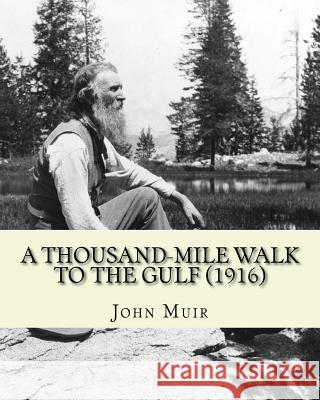A Thousand-Mile Walk To The Gulf (1916). By: John Muir, EDITED By: William Frederic Bade: Illustrated » książka
A Thousand-Mile Walk To The Gulf (1916). By: John Muir, EDITED By: William Frederic Bade: Illustrated
ISBN-13: 9781544150475 / Angielski / Miękka / 2017 / 82 str.
A Thousand-Mile Walk To The Gulf (1916). By: John Muir, EDITED By: William Frederic Bade: Illustrated
ISBN-13: 9781544150475 / Angielski / Miękka / 2017 / 82 str.
(netto: 34,93 VAT: 5%)
Najniższa cena z 30 dni: 36,68
ok. 16-18 dni roboczych
Bez gwarancji dostawy przed świętami
Darmowa dostawa!
Here is the adventure that started John Muir on a lifetime of discovery. Taken from his earliest journals, this book records Muir's walk in 1867 from Indiana across Kentucky, Tennessee, North Carolina, Georgia, and Florida to the Gulf Coast. In his distinct and wonderful style, Muir shows us the wilderness, as well as the towns and people, of the South immediately after the Civil War. John Muir ( April 21, 1838 - December 24, 1914) also known as "John of the Mountains," was a Scottish-American naturalist, author, environmental philosopher, glaciologist and early advocate of preservation of wilderness in the United States. His letters, essays, and books of his adventures in nature, especially in the Sierra Nevada of California and Nevada, have been read by millions. His activism helped to preserve the Yosemite Valley, Sequoia National Park and other wilderness areas. The Sierra Club, which he founded, is a prominent American conservation organization. The 211-mile (340 km) John Muir Trail, a hiking trail in the Sierra Nevada, was named in his honor. Other such places include Muir Woods National Monument, Muir Beach, John Muir College, Mount Muir, Camp Muir and Muir Glacier. In Scotland, the John Muir Way, a 130-mile-long route, was named in honor of him. In his later life, Muir devoted most of his time to the preservation of the Western forests. He petitioned the U.S. Congress for the National Park bill that was passed in 1890, establishing Yosemite National Park. The spiritual quality and enthusiasm toward nature expressed in his writings inspired readers, including presidents and congressmen, to take action to help preserve large nature areas.He is today referred to as the "Father of the National Parks" 4] and the National Park Service has produced a short documentary about his life. John Muir has been considered "an inspiration to both Scots and Americans."Muir's biographer, Steven J. Holmes, believes that Muir has become "one of the patron saints of twentieth-century American environmental activity," both political and recreational. As a result, his writings are commonly discussed in books and journals, and he is often quoted by nature photographers such as Ansel Adams. "Muir has profoundly shaped the very categories through which Americans understand and envision their relationships with the natural world," writes Holmes. Muir was noted for being an ecological thinker, political spokesman, and religious prophet, whose writings became a personal guide into nature for countless individuals, making his name "almost ubiquitous" in the modern environmental consciousness. According to author William Anderson, Muir exemplified "the archetype of our oneness with the earth," while biographer Donald Worster says he believed his mission was ..".saving the American soul from total surrender to materialism."On April 21, 2013, the first ever John Muir Day was celebrated in Scotland, which marked the 175th anniversary of his birth, paying homage to the conservationist. William Frederic Bade (January 22, 1871 - March 4, 1936), perhaps best known as the literary executor and biographer of John Muir, was a versatile scholar of wide interests. As an archaeologist, he led the excavation of Tell en-Nasbeh in Palestine, now believed on the basis of his work to be the biblical city of Mizpah in Benjamin. He was also an ordained Moravian minister, a professor of ancient languages, a theologian and bible scholar, a mountaineer, a conservationist and a naturalist. Born and raised in Minnesota, he studied at Moravian College and its seminary as well as other universities. He served on the faculties of Moravian Theological Seminary and then the Pacific School of Religion. He also served as interim president and subsequently as dean of the Pacific School of Religion and was founding director of the school's Palestine Institute. He was president of the Sierra Club 1919-1922 and edited the Sierra Club Bulletin for 12 years.
Zawartość książki może nie spełniać oczekiwań – reklamacje nie obejmują treści, która mogła nie być redakcyjnie ani merytorycznie opracowana.











